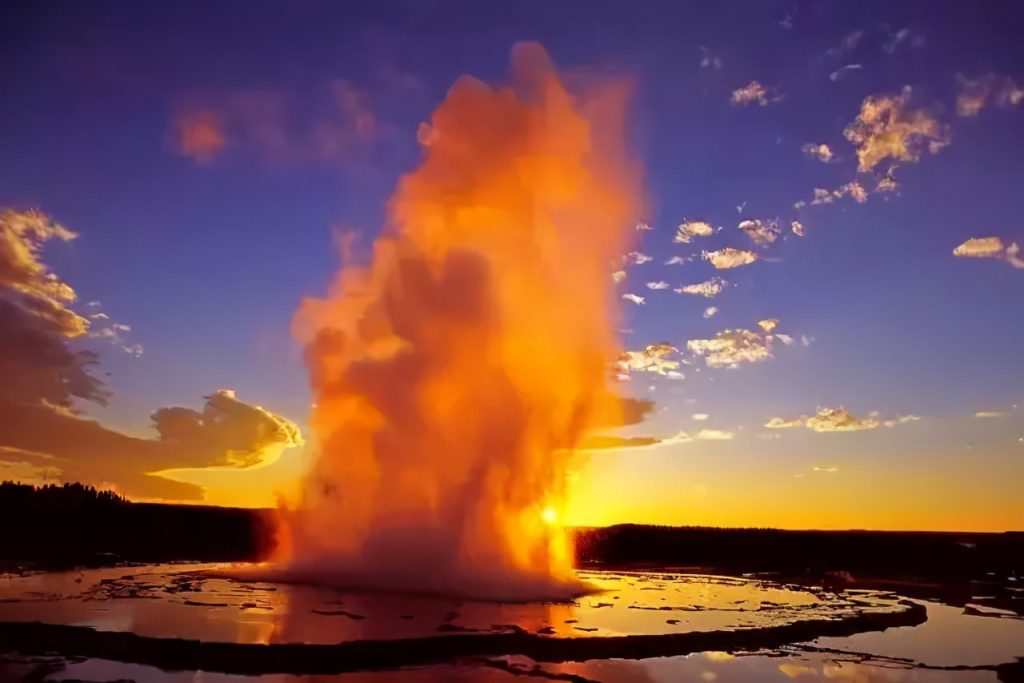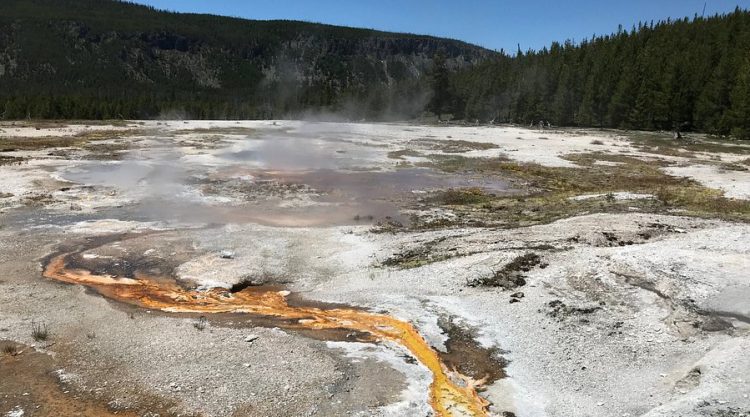Introduction
Yellowstone National Park, one of the most iconic and visited national parks in the United States, is located in the U.S. states of Wyoming, Montana, and Idaho. As the first national park in the world, it holds a special place in the history of conservation and natural preservation. Covering over 3,400 square miles, Yellowstone is home to an incredibly diverse range of natural wonders, including majestic geysers, colorful hot springs, dramatic canyons, vast forests, and an array of wildlife. Whether it’s the powerful eruptions of Old Faithful, the vibrant colors of Grand Prismatic Spring, or the opportunity to witness wild animals in their natural habitat, Yellowstone has long been a symbol of America’s natural beauty.
But what makes Yellowstone National Park truly a must-visit destination? Is it the geothermal activity that drives millions of visitors each year, the extraordinary landscapes, or the rare wildlife sightings? This article will explore the various reasons why Yellowstone is considered one of the best places for nature lovers and why you should consider planning a visit to this remarkable location.
1. A Rich History and Cultural Significance
1.1 The Birth of National Parks
Yellowstone was established as the world’s first national park on March 1, 1872, by President Ulysses S. Grant. The decision to create the park was based on the increasing awareness of the area’s natural wonders and the need to preserve them for future generations. At the time, the concept of preserving natural areas for public enjoyment was a novel idea, and Yellowstone paved the way for the creation of other national parks across the U.S. and around the world.
The land that became Yellowstone was originally inhabited by various Native American tribes for thousands of years before European settlers arrived. Indigenous groups such as the Shoshone, Crow, and Blackfeet tribes have historically used the region for hunting, gathering, and spiritual practices. Today, Yellowstone’s cultural heritage is honored through the acknowledgment of Native American history, and the park offers educational opportunities to learn more about the indigenous peoples who once lived there.
1.2 A Legacy of Conservation
Yellowstone also played a significant role in the development of the U.S. national park system. When the park was founded, the idea of conserving public lands for recreational and educational purposes was still in its infancy. Since its inception, Yellowstone has been at the forefront of conservation efforts, balancing the needs of tourism with the importance of maintaining the park’s delicate ecosystems. Over the years, the park has been a pioneer in scientific research, wildlife management, and preserving its unique natural features.
2. Geothermal Wonders: A Geological Marvel
2.1 The Geysers of Yellowstone
Yellowstone is known worldwide for its geothermal activity, which includes more than 500 active geysers—about half of the world’s total number. Geysers are hot springs that periodically erupt with steam, water, and gas. The most famous geyser in the park, and arguably the most famous in the world, is Old Faithful. This geyser erupts every 60 to 110 minutes, shooting water up to 180 feet in the air. The predictability of Old Faithful’s eruptions makes it one of the park’s most popular attractions, and thousands of visitors gather each day to witness the spectacular display.
In addition to Old Faithful, Yellowstone is home to a variety of other unique geysers, including the colorful Grand Prismatic Spring, which is the largest hot spring in the U.S. The spring’s vivid rainbow colors are caused by thermophiles—bacteria that thrive in the hot water. The Norris Geyser Basin is another major geothermal feature, with the world’s tallest active geyser, Steamboat Geyser, which can erupt to heights of more than 300 feet.
2.2 Hot Springs and Fumaroles
Yellowstone’s geothermal landscape also includes hot springs and fumaroles, which are vent-like features that release steam and gases from deep within the Earth. The park’s hot springs are among the most beautiful in the world, with vibrant colors and surreal formations. The colorful hot springs, such as the Morning Glory Pool, are caused by minerals dissolved in the water, and the water temperature can range from near freezing to over 200°F (93°C).
Fumaroles, which release hot gases, contribute to the park’s mystical atmosphere. These features provide visitors with a unique opportunity to observe the forces of nature at work, as steam rises from the ground and the Earth’s crust seems to breathe.
3. Yellowstone’s Diverse Wildlife
Yellowstone is home to a wide range of wildlife, from the iconic American bison to elusive predators like wolves and grizzly bears. The park’s ecosystems provide an ideal habitat for animals to thrive, and it is one of the best places in North America to witness wildlife in their natural habitat.
3.1 The Yellowstone Wolf Reintroduction
One of the most notable wildlife conservation efforts in Yellowstone is the reintroduction of wolves, which were eradicated from the park in the early 1900s. In 1995, gray wolves were reintroduced into the park, and since then, their population has grown significantly. Wolves play an important role in the ecosystem by controlling populations of other animals, such as elk, which helps maintain the balance of plant and animal life in the park.
3.2 The Return of the Grizzly Bear
Grizzly bears, once in decline in the park, have also made a comeback in recent decades. These apex predators are a symbol of the wildness of Yellowstone, and spotting a grizzly in the park is a rare and exhilarating experience for visitors. Visitors are urged to maintain a safe distance and respect wildlife safety guidelines to ensure both their safety and that of the animals.
3.3 Bison and Other Wildlife
Yellowstone is home to the largest wild bison population in the U.S., with over 4,000 bison roaming freely within the park. Bison were once nearly driven to extinction, but thanks to conservation efforts, their numbers have steadily increased. Visitors often encounter bison along the park’s roads or in the vast plains of Lamar Valley, especially during the spring and fall months.
Other wildlife in the park includes elk, moose, pronghorn antelope, mountain lions, and a wide variety of birds, such as bald eagles and trumpeter swans. Birdwatchers will find plenty to observe in Yellowstone’s diverse ecosystems, from the wetlands to the forests.

4. Iconic Landmarks and Scenic Beauty
Yellowstone’s landscapes are nothing short of breathtaking. From the park’s dramatic canyons to its expansive lakes and pristine forests, there is something for everyone to admire in this natural paradise.
4.1 The Grand Canyon of the Yellowstone
The Grand Canyon of the Yellowstone River is one of the park’s most famous features. This majestic canyon, with its colorful cliffs and waterfalls, is a popular stop for visitors. The Lower Falls of the Yellowstone River, a 308-foot waterfall, is one of the park’s most iconic sites, and it can be viewed from several vantage points along the South Rim Trail.
4.2 Yellowstone Lake
Yellowstone Lake is the largest high-altitude lake in North America, covering over 130 square miles. The lake is surrounded by forests and mountains, and it provides opportunities for boating, fishing, and picnicking. The lake’s beauty is particularly striking during sunrise and sunset, when the calm waters reflect the surrounding landscape.
4.3 Lamar Valley
Often referred to as the “Serengeti of North America,” Lamar Valley is known for its abundance of wildlife. It is one of the best places in the park to view animals like bison, elk, wolves, and bears. The valley is especially popular in the early morning and evening hours, when animals are most active.
4.4 The Yellowstone Caldera
The Yellowstone Caldera, one of the largest active volcanic systems in the world, is another remarkable geological feature of the park. The caldera formed after a massive volcanic eruption about 640,000 years ago, and it is considered one of the most dangerous volcanoes in the world due to its potential for future eruptions. Despite its potential hazards, the caldera’s geothermal activity is an ongoing attraction for scientists and tourists alike.
5. Planning Your Visit to Yellowstone
Yellowstone National Park is open year-round, but the best time to visit depends on the experience you’re seeking.
5.1 Peak Season: Summer
The summer months (June to August) are the busiest in Yellowstone. During this time, the park is fully operational, and most of the accommodations, roads, and attractions are open. The weather is warm, with temperatures ranging from 70°F to 85°F. While summer is ideal for exploring the park, it also means larger crowds and higher accommodation prices.
5.2 Shoulder Seasons: Spring and Fall
Spring (April to May) and fall (September to October) are considered the shoulder seasons in Yellowstone. These seasons offer milder weather and fewer crowds, making them ideal times for those seeking a more tranquil experience. Wildlife is especially active during these times, and visitors can enjoy the changing colors of the fall foliage or witness the birth of animals in the spring.
5.3 Winter: A Winter Wonderland
Winter (November to March) brings a completely different experience to Yellowstone. The park is covered in snow, and many of the roads are closed, but it is still accessible via snowmobiles, snow coaches, and cross-country skis. Winter is a magical time to visit for those who enjoy winter sports or want to see wildlife in a serene, snowy setting.
Conclusion
Yellowstone National Park is a destination unlike any other, offering natural beauty, adventure, and history in one extraordinary location. From its geothermal wonders to its diverse wildlife and stunning landscapes, the park offers something for every type of nature lover. Whether you’re visiting for a day or spending a week exploring its vastness, Yellowstone will undoubtedly leave you with memories that will last a lifetime. So, why not plan your visit and experience the majesty of this world-renowned park for yourself?





















